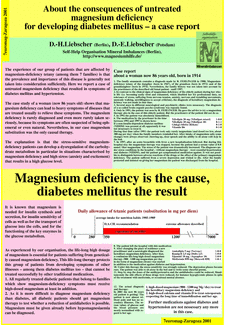Case report about a woman now 86 years old, born in 1914
|
top
|
1. The family anamnesis contains a diagnosis by R. FEHLINGER in 1980:
Magnesium-deficiency tetany of the daughter (born in 1947), of the
grandson (born in 1972) and of the granddaughter (born in 1974).
Nevertheless, the family history was not taken into account by the
practitioners of the described patient - until 1997.
2. In contrast to the clinical signs of magnesium deficiency of the
elderly patient during her whole life (i.e. becoming easily tired and
exhausted, which disabled her for professional duty, no tolerance of
stress, suffering from nervous tension, anxiety, nervous and trembling
movements, unsteady walking, unwillingness to accept criticism), the
diagnosis of hereditary magnesium deficiency was not made in that
time [8].
3. Several stays in different neurological and psychiatric clinics
were necessary. The diagnosis of a so-called brain-organic
psycho-syndrome was repeatedly found.
4. Only in 1991, the patient was seen by R. FEHLINGER. He gave the
advice to try a magnesium therapy also in the case of this elderly
patient. But the practitioners of the patient did not do so.
5. In 1992 the patient was absolutely immobilised.
| Nifedipin 20 mg (Nifedipat retard) |
1-0-0 |
| Nifedipin 10 mg (Nifedipat 10) |
0-1-1 |
| Ginkgo-biloba (Rökan) |
0-1-0 |
| Vitamin B6 |
0-1-0 |
6. The medication by the practitioner in the time between 1992 and 1997
is shown here. If a non-insulin-dependent diabetes mellitus (NIDDM)
was present at all, apparently it was not necessary to treat it.
During that time (after 1991) the patient took only rarely magnesium
(and dosed too low, about 300 mg per day) when the family members
reminded her. After intake of magnesium salts some changes were always
observed: cheering up, clear speech and the ability to sit with
help in the bed.
7. In 1997, after an acute bronchitis with fever a new hospitalisation
followed. But during this hospital stay the magnesium therapy was
stopped, because the patient had a serum value of 0.8 mmol/liter
magnesium. The stress of the patient was dramatically increased.
The diagnoses under stress conditions in the hospital - without
magnesium therapy - were essential hypertension and diabetes (NIDDM),
and the patient got symptomatical medication against.
It was not possible to distinguish between adverse reactions of the
drugs or the effect of the primary magnesium deficiency.
The patient suffered from a severe depression and wished to die.
After the family protested and insisted on giving her magnesium the
patient was discharged from the hospital.
| Amlodipin 5 mg (Norvasc) |
1-0-0 |
| Ramipril 2,5 mg (Delix 2,5) |
1-0-0 |
| Xipamid 10 mg. (Aquaphor 10) |
1-0-0 |
| Metformin 850 mg (Mescorit 850) |
1-0-1 |
8. The patient left the hospital with this medication.
9. After changing the place of residence a new practitioner and a
neurologist diagnosed the hereditary magnesium deficiency. After that,
a continuous life-long high-dosed magnesium therapy (900 - 1200 mg
magnesium per day in the form of magnesium citrate) was started in
addition to the medication against diabetes and hypertension.
10. Under this therapy the stress sensitivity was strongly
reduced. The depression phases became rare. The patient was able to
sit in the bed alone and to write some cheerful poems.
11. Step by step the doses of the antihypertensiva and the
antidiabetics could be reduced. Simultaneously the side effects of
these drugs were reduced, for instance hypoglycemic phases in spite of
the treatment with metformin, or occasional mental absence.
12. The actual diagnosis and therapy: In 2001 the now 86 years old
patient is getting:
- high-dosed magnesium (900 - 1200 mg Mg / day) to treat the
hereditary magnesium deficiency and
- high-dosed calcium and vitamin D to treat osteoporosis respecting
the long time of immobilisation and her age.
The patient is now almost without pain and has no secondary
illnesses. The serum values of glucose and the blood pressure are
nearly normalised with regard to her age.
Further medications
against diabetes and hypertension are not necessary any more in
this case.
|

